
Suspended Animation #404
While I have great respect and appreciation for the work of Charlie Chaplin and Buster Keaton, the silent movie comedians who consistently still make me smile and laugh are Stan Laurel and Oliver Hardy.
With the release of their film shorts to television in the 1950s and 1960s, there was resurgence in interest in them.Unfortunately, they couldn’t fully enjoy it because Hardy died August 7, 1957 and Laurel in February 23, 1965 although Laurel was honored with a Lifetime Achievement Academy Award. However, neither received residuals for their work.
Larry Harmon has always been a controversial personality. His adeptness at self-promotion resulted in him claiming things like the creation of Bozo the Clown with little or no scrutiny. He claimed a deep friendship with Stan Laurel that is certainly undercut by one of Laurel’s last letters three days before his death where he claimed he had talked with a lawyer about suing “that a**hole”.
Harmon approached Laurel and his wife Eda in 1961 about generating more income for the couple by his producing an animated series based on the film characters of Stan and Ollie. Harmon also negotiated with Hardy’s widow, Lucille, at the same time for the “likenesses” of the famous comedy pair.
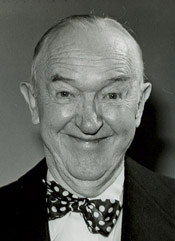
Stan Laurel in 1963
Harmon gave Laurel the impression that he was only signing a contract for an animated pilot for NBC that might lead to a series and signing for merchandise rights to only that pilot. That was not the case.
He also gave the impression he would use Chuck McCann, a friend of Laurel’s, as the voice of Hardy which met with Laurel’s approval. McCann never got along with Harmon and Harmon used Jim McGeorge instead.
NBC in an announcement in the New York Times October 22nd, 1961 said that the show “would be televised in color in prime time although the weekly half-hour period has not been selected.”
In a United Press International press release dated May 7, 1961, Laurel said about the proposed project that “I hope they’ll be good. Our films approached ‘cartoonery’ and some of the things we did in the movies could be done in cartoons” referring to some of the exaggerated physical gags in the films.
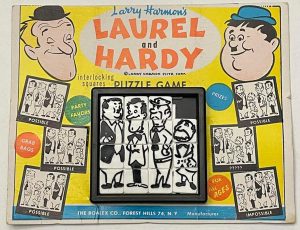 “I hope they won’t do all the plots of our movies in the TV series. They should have fresh stories for the cartoons,” said Laurel who said he planned to confine his activities to script consultation suggesting story lines from his home and concentrate on dialog.
“I hope they won’t do all the plots of our movies in the TV series. They should have fresh stories for the cartoons,” said Laurel who said he planned to confine his activities to script consultation suggesting story lines from his home and concentrate on dialog.
The Los Angeles Times in May 1961 reported: “Laurel and Hardy, the most successful and durable team of comics in the history of entertainment, will be on television next fall—as a cartoon series.
“The idea of taking the human characters and turning them into cartoon characters is Larry Harmon’s. ‘We’re going to do Laurel and hardy as a half-hour cartoon series,’ Mr. Harmon explained. ‘The figures will be those of Laurel and hardy and the voices will be theirs, too’.
“At this juncture, Mr. Harmon, who is the voice of Bozo the Clown, did an imitation of Stan Laurel which caused near-by heads to swivel. “When I call Stan sometimes I imitate his voice,” Mr. Harmon said. “He still can’t get over it. ‘It’s like talking to myself,’ he told me once.”
 Of course, Hardy could not provide his voice because he had died four years earlier and Laurel had indicated he did not want to do the voice without “Babe” and the fact that he felt having grown older he wouldn’t be able to match his voice in the films. Harmon did the voice of Laurel in the series but examining the episodes, it changes and some say improves as the series went on.
Of course, Hardy could not provide his voice because he had died four years earlier and Laurel had indicated he did not want to do the voice without “Babe” and the fact that he felt having grown older he wouldn’t be able to match his voice in the films. Harmon did the voice of Laurel in the series but examining the episodes, it changes and some say improves as the series went on.
On January 11, 1962, Laurel wrote to Richard Sloan, “I very seldom see or hear from Mr. Harmon so know little about his affairs concerning the cartoon series. I understand they have started production (I read in the trade papers here). That’s all I know about it.”
Several letters from 1962 and 1963 repeat over and over again that Laurel had not heard from Harmon. Laurel apparently was shown a small animation “test” that disappointed him and felt was “lousy”.
Through Variety, Laurel learned in 1963 that the NBC deal was cancelled and Harmon was looking for a syndication deal. Harmon never told Laurel what happened with NBC. Supposedly, there is a 16mm copy of the pilot out there somewhere.
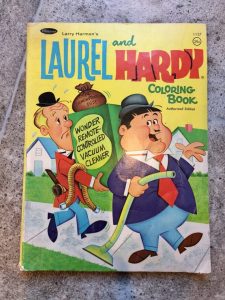 Harmon produced some items with the Laurel and Hardy cartoon figures including a plastic coin bank with Laurel’s likeness that Laurel never knew existed until one of his fans sent him a picture of some of the toys. It is unclear whether Laurel or his wife ever received any royalties from these items. Part of the profits from the cartoon series did eventually go to Laurel’s widow.
Harmon produced some items with the Laurel and Hardy cartoon figures including a plastic coin bank with Laurel’s likeness that Laurel never knew existed until one of his fans sent him a picture of some of the toys. It is unclear whether Laurel or his wife ever received any royalties from these items. Part of the profits from the cartoon series did eventually go to Laurel’s widow.
David L. Wolper, a documentary film maker, had aligned himself with Hanna-Barbera and had acquired the rights to make a cartoon version of Laurel and Hardy. After Laurel’s death, he approached Hanna-Barbera about making an animated series.
Harmon found out and claimed that he owned the rights for a series. In a legal challenge, it was argued that while the contract may have given Harmon the right to the character from the films, it did not extend to the actual person.
Finally, after much bickering both parties agreed on a state of affairs where two opposing parties agreed to disagree with Harmon giving permission to use the characters in exchange for his film company Jayark getting the distribution rights.
So it was a strange, uneasy partnership that produced the cartoon series.
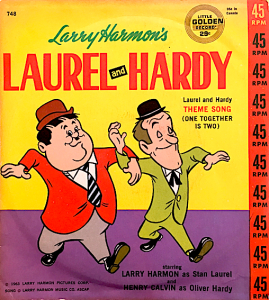 The Laurel and Hardy cartoon show was an animated series with 156 episodes each running about five to six minutes and usually packaged as 62 half hours in syndication. They premiered in September 1966. HIT Entertainment acquired the rights to the series in 1998 and re-packaged the shows with new titles and theme music (Have a Party with Laurel and Hardy).
The Laurel and Hardy cartoon show was an animated series with 156 episodes each running about five to six minutes and usually packaged as 62 half hours in syndication. They premiered in September 1966. HIT Entertainment acquired the rights to the series in 1998 and re-packaged the shows with new titles and theme music (Have a Party with Laurel and Hardy).
Besides McGeorge and Harmon, veteran cartoon voice actors including Janet Waldo, Don Messick and Paul Frees as supporting characters.
One episode of the series Love Me, Love My Puppy is an unofficial remake of the 1931 Laurel and Hardy short Laughing Gravy where the duo try to conceal a happy puppy from an irritable landlord seeking to enforce a no-pets rent clause.
Most Laurel and Hardy fans disliked the series because not only did it not try to capture the style and charm of the comedy team but instead substituted the same story ideas and gags that were in other Hanna-Barbera cartoon series of the time. The show concentrated more on dialog than slapstick action.
Some argue that despite its many flaws, the series did introduce the characters to a new generation, created a plethora of collectible merchandise and kept the spirit of Laurel and Hardy alive.
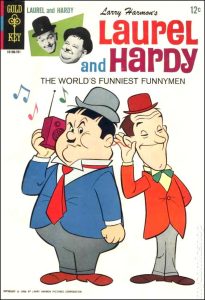 Critic Leonard Maltin said, “To criticize these cartoons is pointless. Any imitation, even a good one, simply cannot be Laurel and Hardy… No one can duplicate Laurel and Hardy’s greatness because they were unique.”
Critic Leonard Maltin said, “To criticize these cartoons is pointless. Any imitation, even a good one, simply cannot be Laurel and Hardy… No one can duplicate Laurel and Hardy’s greatness because they were unique.”
In 1975, Harmon was embroiled in a lawsuit with Hal Roach who had produced the original Laurel and Hardy shorts over the rights to portray Laurel and Hardy. Harmon won in a New York court. ”It was an expensive fight,” Harmon told the New York Times. ”It cost me $500,000.”
In the March 24, 1985 issue of Advertising Age, Harmon announced he was planning a new Laurel and Hardy animated mini-series and was hiring twenty to thirty animators to work on it.
In addition, he was going to produce a Christmas “fairy tale” special about the comedy pair meeting Rapunzel “based upon a story written by himself and Stan Laurel that will feature nine new songs by Jerry Livingston”.
Of course, ever the entrepreneur, Harmon also promoted an upcoming Broadway musical featuring the comedy duo, a live action film about the sons of Stan and Ollie with Harmon playing the son of Stan, new toys and more.


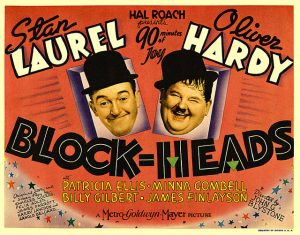
 Jim Korkis is an internationally respected animation historian who in recent years has devoted his attention to the many worlds of Disney. He was a columnist for a variety of animation magazines. With his former writing partner, John Cawley, he authored several animation related books including The Encyclopedia of Cartoon Superstars, How to Create Animation, Cartoon Confidential and Get Animated’s Animation Art Buyer’s Guide. He taught animation classes at the Disney Institute in Florida as well as instructing classes on acting and animation history for Disney Feature Animation: Florida.
Jim Korkis is an internationally respected animation historian who in recent years has devoted his attention to the many worlds of Disney. He was a columnist for a variety of animation magazines. With his former writing partner, John Cawley, he authored several animation related books including The Encyclopedia of Cartoon Superstars, How to Create Animation, Cartoon Confidential and Get Animated’s Animation Art Buyer’s Guide. He taught animation classes at the Disney Institute in Florida as well as instructing classes on acting and animation history for Disney Feature Animation: Florida.




















































During my childhood in the 1960s, the Laurel and Hardy films must have been televised on Sunday mornings when my family was in church, so I first became acquainted with the duo through the merchandising campaign spawned by Larry Harmon. I was in a toy store, and I found a blister pack containing a couple of cartoony-looking bendy-limbed Laurel and Hardy figures. On the cardboard backing was an illustration showing the two of them walking away from a half-painted fence, with the paintbrushes and buckets lying on the ground, as a helmeted policeman peered ominously over the fence at them.
I remember looking at that picture and trying to make sense out of it. So Laurel and Hardy are… fence painters? They’re obviously not very good fence painters, walking off the job like that, but why is the policeman interested? Is it a crime not to finish painting a fence once you’ve started? Already my parents had been giving me little chores to do around the house, and I was well aware of how easy it was for a little kid to get in big trouble without meaning to. Can you get arrested and go to jail for not completing your chores? What further horrors did life have in store for me? I was very upset and disturbed by this Laurel and Hardy toy set, and Larry Harmon didn’t get a penny out of my parents that day.
I didn’t discover Laurel and Hardy’s films until I was an adult. Better late than never, as they say. To date I haven’t seen one where they get arrested by a Keystone Kop for failure to paint a fence, but if there is such a film out there, I would be grateful to any Sons of the Desert who can direct me to it.
I couldn’t help noticing that in the H-B cartoon, Laurel and Hardy never got around to finish painting the firehouse.
That’s another fine post you’ve written, Jim, and I look forward to another year of anecdotes from you!
I actually saw Laurel and Hardy in cartoon form first as guest stars in THE NEW SCOOBY-DOO MOVIES before I saw any of the 1966 cartoons. I had heard of the duo and had seen clips and photos of their films, and I knew that they were dead. So it had always puzzled me how Scooby and the gang could meet two dead celebrities in 1972; I thought Laurel and Hardy should have been the ghosts and the guests of that episode.
Scooby Doo had Laurel and Hardy and Batman and Robin- they were the original multiverse.
I never saw these air during childhood, or later–They don’t seem to have had the ubiquity the Abbott & Costello cartoons enjoyed.. Speaking of which, I think when H-B produced the A&C cartoons afterward, it was hard to come up with even more plots involving a comedic duo, which is why it seems that every other short of theirs involved an animal or inanimate object becoming a giant monster. While the L&H cartoons aren’t much better, I am impressed that their bits of physical business, such as Ollie’s finger-twiddling and Stan’s head-scratching were incorporated into the animation.
I was introduced to the wonderful antics of Laurel and Hardy through their own films being broadcast on one of our syndicated channels. I thought they were terrific! Then, of course came the holiday airings of “Babes in Toyland“ (1934) featuring the duo.
Then I had seen one or two of these Laurel and Hardy cartoons by Bill Hannah and Joe Barbara, and they just didn’t click with me. They were like any other characters. You could’ve put Fred Flintstone in the same situation, although you would have to change all the designs of the background characters and all that other stuff, but I think you know what I mean.
Yet, I did occasionally watch the “bozo the clown“ cartoons by Larry Harmon. I liked some of them. This is possibly because I did like the art of UPA studios, even through their “Dick Tracy“ and “Mr. Magoo“ phases. All I have to say is that I’m glad Larry Harmon never got his mitts on the opportunity to make a Marx Brothers cartoon series. As a child, I never saw the Marx brothers films, but I’d seen good representations of them through the Warner Bros. cartoons antics of bugs bunny and anyone else who imitated Groucho Marx. I didn’t mind anything done with a genuine wit, and I knew those cartoons, the made-for-TV cartoons, at that time would not do it for me.
The thing about the truly great comedians is that their essence can be approximated but never truly captured. No matter how well the copy is fabricated it is based on what they did not on what they do. However these cartoon versions serve to acquaint kids with their names. There is nothing like watch Chaplin, Keaton, Laurel and Hardy and others is a big theater with hundreds, sometimes thousands, of other people. Ditto Hollywood cartoons at their best. We don’t get that caliber of audience reaction anymore. Neat post. Thank you.
And a tip of the hat to our dear departed friend David Mruz who brought as all together with his wonderful zine, MINDrot.
Looks like Carlo Vinci did the animation on “False Alarms”, for anybody keeping track.
Yes, Vinci animated the first part of the cartoon and his frequent ‘partner’ Hugh Fraser the second part. They were often paired on H-B cartoons during the early-mid 60s. Vinci had a talent for even making portly characters like Hardy move with agility.
I saw these back as a young kid when they first aired! Loved the mannerisms that got used from open t close from the old shorts….
Great article – thanks, Jim! What I want to know is the current ownership status of the rights to their likenesses. I believe that Harmon’s company (daughter) still holds most of the rights, even though nothing is happening with them.
“The Laurel and Hardy Scrapbook” by Jack Scagnetti (c1976) paints the legal battles as an unqualified triumph for Larry Harmon, who evidently gave the author a persuasive interview. In the book, Harmon announces expanded merchandising, franchised L&H pizza palaces and pie shops, an amusement park, and an animated theatrical feature for 1976. The 1982 paperback reprint doesn’t update these grand predictions.
As a L&H fan from way back (bought/borrowed 8mm Blackhawk Films), I was aware of the cartoons thanks to random merchandise but never saw one until adulthood, when I stumbled across a local Bozo show that included them. I assumed they were just part of the franchise, packaged with Harmon’s own Bozo toons.
I don’t know about ownership of the screen characters, but I do know American rights to most of their talkies were, for many years, owned by disinterested corporations. It was many years before Yankees could get discs of L&H’s talkie shorts, unless they sprung for region-free players and foreign releases. Nowadays there are two solid American releases that encompass most of their sound shorts and features for Hal Roach.
Meanwhile, HB produced a short-lived Saturday morning cartoon based on another Hal Roach franchise, The Little Rascals. Haven’t seen that anywhere beyond some stills.
Yeah, there was an animated “Little Raxcals” series that ran on Saturday mornings for a season or two in the early 1980s.
Odder still, King World — distributor of the original Rascals shorts for television at the time — had clay-animated versions made of a handful of the films in the early 1970s, using the original sound tracks.
Harmon was like a lot of low-rent independent producers. Always full of plans for projects that never came to fruition.
The Laurel and Hardy cartoons aren’t awful. They’re not very good, but not awful. The biggest problem I have with them is how generic they are. Almost all of the scripts could have been rewritten for any H-B comedy team without that many changes being made
Chuck McCann was a terrific Oliver Hardy. Here is Chuck as Ollie in a commerical for Arby’s.
https://youtu.be/WEvYJ9cgY5g
As hard as Larry Harmon and Hanna-Barbera tried, the genius of such comedians as L&H and A&C is invariably difficult to replicate, even with the best animators and voice artists. To this day, nothing gets me ROFL like the Hal Roach Studio late silents and early talkies starring Laurel & Hardy and Charley Chase.
I also extend a respectful tip of a battered top hat worn by Max Linder to our departed pal David Mruz and Mindrot/Animania.
Larry Harmon did in fact produce a live-action “New Adventures of Laurel and Hardy” feature, “For Love Or Mummy,” which as far as I know was never released theatrically, but went direct to video (VHS) in 1999. Bronson Pinchot was cast as Stan, and Gailard Sartain played Ollie. John R. Cherry III (the “Ernest” movies) directed and wrote, though (not unexpectedly) Harmon cut himself in for screen credit as co-director and co-writer. I saw the movie 20 years ago or so; it’s pretty awful.
Let’s be honest. Larry Harmon’s Bozo cartoons were pretty bad, with flat animation, dull villains and pedestrian plots. The Laurel & Hardy shorts were only marginally better. The Three Stooges and Abbott & Costello toons were no great laugh-getters either for similar reasons. There’s a Claymation-type Marx Brothers short on You Tube, called The Three Marx Brothers (1962) that’s miles better than any of them.
https://youtu.be/5mBh1FhOlJ0?si=6ZcHlSNwHc_H1u6e